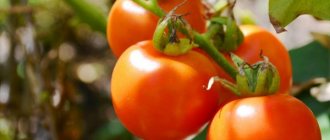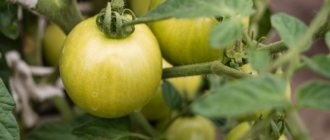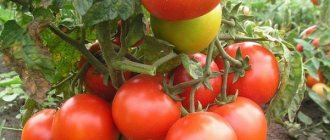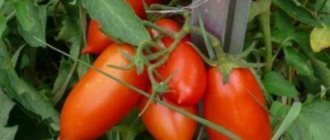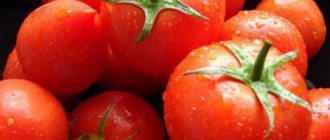Home / Vegetable garden / Tomatoes
Back
Published: 10/18/2020
Reading time: 16 min
4
Tomato hybrids have long won the hearts of gardeners. New items appear every season. Once upon a time, Katya tomatoes were among them, delighting with relatively simple care, early harvest and excellent taste of the fruit.
The variety is not just early ripening, but ultra-early, which is especially valued by summer residents of regions located in risky farming zones. The fruits are of universal use. Having planted such a tomato, you can count on fresh salads, marinades and pickles, adjika and lecho.
- 1 Description
- 2 Characteristics of fruits
- 3 Advantages and disadvantages
- 4 Comparison with other hybrids
- 5 Features of growing carpal type hybrids 5.1 Caring for seedlings
- 5.2 Agricultural technology
Description of the tomato variety Katya
Katya F1 is an ultra-early variety, one of the best. The fruits ripen in 75-80 days. High-yielding - 10 kg are collected per square meter, and in greenhouses 1.5 times more. The plant is low-growing, up to 70 cm tall, but requires obligatory garter, especially fragile branches with heavy clusters of fruits.
The bunches contain up to 8 flat-round, smooth, red tomatoes, weighing up to 130 g. They have a good taste. This variety is a salad variety, but is also great for canning, pickling, making tomato juice and other preparations. More often they are consumed fresh, because they ripen early, when they are not yet preserved.
The fruits all ripen almost simultaneously, so the main harvest is harvested immediately. These tomatoes last quite a long time. It is recommended to remove slightly unripe fruits for storage and transportation for sale - they ripen quickly, within a few days. After the main harvest, Katya tomatoes still bear fruit, but the number of ovaries is formed much less.
Tomato Katya pink F1
Included in the State Register of the Russian Federation in 2021. While it is still new, it has already gained many fans. In terms of its varietal qualities, yield, agricultural cultivation technology used and other indicators, the characteristics of the tomato Katya rozovaya F1 fully correspond to the main variety.
It differs only in the color and taste of the fruit.
Fruit characteristics
Tomatoes ripen approximately 80-85 days after germination. Each bunch contains 6-8 tomatoes. Similar hybrid forms were bred by breeders for industrial cultivation, so tomatoes ripen almost simultaneously, do not fall off, and do not rot on the bushes.
| Fruit shape | Flat-round |
| Color | Red |
| Weight (g) | 80-94 |
| Number of slots | 3-4 |
| Content of main substances (%) | Sugar - 2.4; dry matter - 4.6 |
| Taste | Great |
| Yield indicators | Open ground - 8-11 kg/m², greenhouse - 14-16 kg/m² |
| Marketable fruit yield (%) | 84-90 |
The tomatoes are aligned in the bunch, approximately equal in weight. At the ripening stage they are light green, when fully ripe they are bright red. The fruits are tasty (which is not so common in early hybrids), sweet, with a slight sourness. In the list of the State Register, the hybrid is declared as a salad hybrid.
According to reviews from summer residents, the fruits are suitable for preservation:
Tatyana, Ulyanovsk
I have been planting Katya tomato for three years now. I'm very happy. I made early salads from it, the taste is good - real tomato. At the end of August last year, the fruits that had ripened in the boxes were harvested. I made a couple of jars of canned ones to try, and they turned out dense and very aromatic tomatoes. This season I will specially roll this one into jars with other varieties.
Advantages and disadvantages
Katya tomatoes are popular in private households and are very loved by farmers for their high yield and marketability suitable for commercial cultivation.
Advantages of Katya F1 tomatoes:
- ripen very early;
- excellent taste for a hybrid;
- versatility of use;
- high performance for commercial cultivation - keeping quality, transportability;
- beautiful fruits, do not crack;
- high-yielding variety;
- unpretentiousness;
- resistance to most tomato diseases.
Flaws:
- fragility of stems - they need to be tied up, especially clusters with fruits;
- Phomosis damage is a disease that can be easily prevented by following the rules of agricultural technology (regular loosening of the soil, moderate watering, frequent ventilation of greenhouses), and spraying the bushes with special means.
Characteristics of tomato Katya
Tomato Katya f1 collects mostly positive reviews even from experienced gardeners. Many summer residents appreciate the beautiful, tasty fruits and ease of caring for the bushes. There is also a variety of this hybrid - pink Katya tomatoes. It has a different color of the fruit and improves its taste. The tomato variety pink Katya will appeal to lovers of everything unusual.
Productivity and fruiting
The description of the tomato variety Katya F1 indicates a fairly high yield. In open ground conditions, up to 10 kg per bush is obtained, and in a greenhouse you can collect up to 15 kg. Marketable fruits account for about 90% of the total harvest.
Area of application of fruits
Tomato variety Katya F1 is consumed fresh, and is also used for preparing canned food, juice, and tomato paste. They have excellent shelf life and transportability, which is why tomatoes are also used for commercial purposes.
Resistance to diseases and pests
Katya tomatoes have strong immunity to the most common diseases: blossom end rot, Alternaria blight, late blight, tobacco mosaic virus, verticillium and fusarium. But this hybrid is subject to pest attacks on a par with other tomatoes.
Advantages and disadvantages of the variety
Hybrid Katya F1 has the following advantages:
- good taste;
- excellent commercial characteristics of the fruit;
- immunity to disease;
- low maintenance requirements;
- high yield rates;
- early ripening;
- tomatoes ripen evenly;
- fruits tolerate transportation well;
- tomatoes do not crack.
The main disadvantage of tomatoes of the Katya F1 variety is brittle branches. Therefore, the bushes must be provided with additional support by tying them to a peg, for example. Sometimes there are cases of damage by Phoma and tomato mosaic.
Features of growing seedlings of the Katya variety
To grow Katya F1 tomatoes, you do not need to create any additional care conditions. Agricultural technology is the same as for most other types of tomatoes. Since this is a hybrid, you need to buy new seeds every year, because those collected from the fruits do not have the necessary properties.
Timing for planting seeds
When to plant seeds is determined by the climatic conditions of a given region, taking into account the fact that after sowing the seeds, the seedlings are grown for 2 months, then they are planted in the beds, and after a month the first harvest ripens.
In warm regions, seeds are planted in boxes for seedlings at the end of February. And in colder climates, if there is no greenhouse, bushes are planted in open ground in early June. In this case, seeds for seedlings are sown at the end of March.
There is another way. The seeds are planted in open ground (covered with film) in early May and kept under cover for a month. But then fruiting will only occur in the second half of summer. At the same time, the early ripening properties of this variety are lost.
Seed preparation
Seeds purchased in a store have already been processed - they do not need to be disinfected and then their preparation includes only the following steps:
- calibration - remove damaged and small seeds, check them in a saline solution for germination (those that do not float but remain at the bottom of the container are suitable for sowing);
- soaking - lay the seeds on a wet cloth or foam rubber, and cover with a damp cloth on top; it takes about 18 hours for them to swell; long roots should not be allowed to sprout, because they are brittle;
- hardening - after soaking, seeds are placed in conditions with a low temperature (for example, on the bottom shelf of a refrigerator) so that they better adapt to unfavorable conditions, while the germination of seeds and the immunity of future plants increases.
Soil requirements
To grow seedlings, it is best to buy ready-made soil for tomatoes, which is perfectly balanced in terms of nutrient composition and acidity level.
Some gardeners prefer to prepare the soil themselves.
Composition of soil mixture for seedlings:
- garden soil;
- compost;
- sand;
- peat;
- dolomite flour or wood ash to neutralize soil acidity;
- mineral fertilizers;
- You can add sphagnum moss to improve the breathability of the soil.
Planting scheme
Sowing seeds is done immediately in separate pots or first in containers for subsequent picking into small pots:
- Drainage is placed at the bottom of cups or containers, and soil 5 cm thick is placed on top.
- In containers, each seed is placed 2-3 cm apart from each other.
- sprinkle no more than 2 mm of soil on top.
- Water with water from a spray bottle.
- Cover with film or glass and place in a warm, well-lit place.
Seedling care
To obtain full-fledged seedlings, they provide high-quality care for them.
- The glass lid of the container is opened daily for ventilation, and after the sprouts emerge, they are removed.
- Maintains optimal temperature, lighting and humidity levels in the room.
- Feeding is done periodically.
- Regular moderate watering is provided using a spray bottle.
- Picking is done after the first pair of true leaves appear. The seedlings are watered generously, and then carefully, using a teaspoon, removed from the container and placed in the prepared pot.
- When the plants take root and become stronger, water them in the standard way using a watering can. Water should not be allowed to get on the leaves to prevent diseases.
- Lighting is very important; daylight should be at least 12 hours. In case of its deficiency, phytolamps are used.
Planting seedlings in open ground
For the Katya variety, beds should be selected on loamy or sandy loam areas, the soil should be breathable. If the soil is acidic, then every 3 years you need to add lime or dolomite flour (300-600 g per square meter).
When there is no suitable soil for a garden bed on the site, it can be prepared. River sand (1 bucket per square meter) and compost are added to heavy clay soils. If you add sand and organic matter annually for at least 5 years, the soil will become loamy.
The time for planting Katya tomatoes in open ground depends on the region - in the southern ones it is the beginning of May, and in the more northern ones from early to mid-June. The soil should already be well warmed up and frosts should not return.
The seedlings must first be hardened off. To do this, when the weather is warm, it is taken out into the garden during the day for several hours and placed in partial shade. This procedure significantly increases the adaptation of plants in a new location.
Holes in the garden bed are made with the calculation of 5-6 bushes per square meter. They are pre-watered and then the seedlings are planted. The stems are buried a little more than the level at which they were in the containers. Then the plants are watered and sprinkled with soil on top.
Tomato care
Preparing seedlings is only the first stage towards obtaining a good harvest. It is necessary to follow all the rules for caring for these plants in the future. Proper agricultural technology for caring for this variety requires the fulfillment of several mandatory conditions.
Watering
This ultra-early variety needs moderate regular watering. Each hole requires up to 1 liter of water, but it should not be allowed to stagnate in it. Water should not get on leaves and fruits. The most favorable time is morning and evening.
Watering is most important during the period of adaptation of seedlings to a new place, in the heat, when flowering begins.
Fertilizer
Tomatoes are fed for the first time 10-12 days after planting the seedlings. Organic and mineral fertilizers are used. To 9 liters of water add 1/10 of the volume of mullein and 20 g of superphosphate. This solution is enough for 10 plants. The next 2 feedings are done every 2 weeks. Mineral fertilizers are used.
Stepsoning
It is important to form the bushes correctly. This procedure is necessary to remove excess shoots so that the fruits develop better.
It is advisable to do pinching in the morning. For pruning, use scissors or a knife. Leave one or two stems.
Loosening
This variety is regularly hilled, especially in areas with heavy soil. The first loosening is done 1.5 weeks after planting the seedlings, subsequent ones every 2 weeks. Before this procedure, the tomatoes are watered - hilling with damp soil improves root growth.
How to care for tomatoes of the “Katya” variety?
The Katya hybrid does not cause much trouble. Care comes down to standard agrotechnical measures - watering, loosening, weeding, fertilizing.
Watering and fertilizing
Water the tomatoes in the evenings. Watering rate is 0.9-1 l. Watering frequency is once every 2 days. When the ovaries form, when fertilizing is applied, the plantings are watered additionally. In hot weather, the frequency of watering is increased, and in high humidity, it is reduced.
The productivity of “Katya” depends on the timeliness and composition of fertilizing. When and what to feed tomato plantings – see Table 2.
table 2
| Feeding period | What to feed? |
| 2 weeks after landing | Apply complex fertilizer. Experienced gardeners prefer to add mullein to the roots of tomatoes - dissolve 500 g of manure in 10 liters of water. This volume is enough for 10 plants. |
| During flowering | Mullein is used with twice the concentration. At the same time, it is advisable to add superphosphate (20 g) - it is placed directly into the mullein. |
| After a couple of weeks | Fertilizing without nitrogen. Pour an infusion of ash or phosphorus-potassium fertilizers under the root. |
Pinching and staking the plant
The hybrid can do without pinching, since it has little foliage. But if you have time and desire, it would be useful to remove the lower stepsons - they are carefully cut off or broken off. Do this in the morning - the sun will heal the wounds better. If you break off the stepsons in the evening, the wound surface risks rotting.
The bushes form 2 stems. Usually the second stem is a stepson that grew earlier than the others. If you leave 3 stems, the plant will not be able to provide nutrition to all the fruit. As a result, instead of normal fruits, tomatoes the size of a walnut will grow.
Due to the fragility of the stems, gartering is a necessary procedure. The plants are tied to supports or trellises, which are made of thick twine stretched between the posts.
Diseases and pests
Tomato Katya F1 is resistant to many diseases typical of tomatoes, except fomoz (brown rot), which can be prevented by using copper oxychloride for spraying. But, unfortunately, it is susceptible to pest attacks, like other garden plants. The root system is affected by mole crickets, May beetle larvae, and wireworms. They are fought with mechanical methods and the use of special poisonous granules, which are added to the holes during planting.
Ground parts are damaged by aphids, whiteflies, and cutworm caterpillars. To combat them, spraying with solutions of special preparations (Aktara) is used.
Description
The plant is of a determinate type, that is, not tall, which makes it easier to care for. In open ground the height is 60 - 70 cm, in closed ground - 1 meter. The stem of the variety is of medium thickness, the internodes are short. The tomato bush is not too branched, with medium foliage. Katya's leaves are petiolate, green, of normal size and type, with a slightly corrugated surface. The inflorescence is simple, without branches. The first fruit cluster is laid over the 5th - 6th leaf, the subsequent ones are formed after 1 - 2 leaves. The brushes are well filled, each containing up to 7 - 8 ovaries. The stalk is articulated; the place where the stalk attaches to the tomato is wide.
Katya's fruits have good density, a smooth surface, and a shape from round to flat-round. In terms of size, they can be called one-dimensional. The average weight of the fruit of the variety, according to the State Register, is 80 - 92 grams, according to the originator - the weight is from 110 to 130 grams. The skin is dense, not thick, glossy. An unripe tomato is light green, without a spot at the stalk. When ripe it turns red. The pulp is aromatic, which is rare in hybrids, fleshy, tender. The taste is sweet and sour; gardeners note that for early tomatoes the taste is more than good. The State Register describes the taste of tomato as good and excellent. The number of seed nests is only 3 - 4 pieces. 100 grams of freshly squeezed juice contains 4.6% dry matter, 2.4% total sugar.
Mr. Summer Resident recommends: cleaning and using tomatoes Katya
Thanks to its productivity and unpretentiousness, the Katya tomato variety pleases even inexperienced gardeners with an abundance of ripe, tasty tomatoes. Since the bulk of the crop ripens at the same time, it is better to take care of its preservation in advance.
For fresh salads, some tomatoes are left on the bushes until fully ripe. To provide yourself with fresh tomatoes for a longer time, it is better to remove part of the harvest with slightly unripe fruits - they will ripen and be stored for quite a long time.
The flesh of Katya F1 tomatoes is dense, the skin does not crack, so they are excellent for canning. The harvest is harvested when the tomatoes are already ripe, but strong and not overripe.
For an overview of tomato seeds, watch the video
If you grew Katya f1 tomatoes, please write if you liked their taste and yield? Where did you grow them and how tall was the bush? Will you grow them again? Briefly describe the advantages and disadvantages (pros and cons) of this tomato in your opinion. If possible, attach a photo of the entire bush or individual fruits you grew to your comment. Thank you!
A huge number of tomato varieties with photos, descriptions and reviews from gardeners in our Tomato Catalog. Enjoy watching.
Your feedback on the Katya tomato and additions to the description will help many gardeners evaluate this hybrid more objectively and decide whether it is worth planting or not.
to contents
This is interesting: Types of hibiscus and their photos - we study in detail
Characteristics of the tomato hybrid Ekaterina
It is never a bad idea to study the description of nightshade crops before purchasing planting material.
The tomato is included in the Russian state register as suitable for cultivation in unheated greenhouses and spring greenhouses.
Tomato Ekaterina F1 belongs to the first generation hybrids. The variety is early ripening; from the moment the seeds are planted in the ground until the first vegetables turn red, it takes from 85 to 95 days.
Tomatoes are low-growing, determinate hybrids. The bush does not grow more than 70 cm in height.
The richest harvest can be obtained if you form a bush with 2 or 3 stems. Constant stepsoning is required. The leaves of the plant are small and rich green in color. Tomato inflorescence is intermediate. The very first inflorescence is formed above the 7th – 8th leaf.
The plant tolerates unfavorable climates well.
One of the main advantages of the Ekaterina F1 tomato is its immunity to many diseases that most often affect nightshade crops. These are late blight, brown and gray rot, fusarium wilt of bushes.
You can cultivate plants both in vegetable gardens and in greenhouses. Moderate feeding is required.
Description
The plant is low, determinate, 70 - 80 cm tall. The leaves are ordinary, green, medium in size. The inflorescence is simple. The fruit raceme contains 5 - 6 ovaries. Pedicel with articulation. The fruits are flat-round in shape, with a smooth surface, of moderate density. An unripe tomato is green, a ripened one is pink. The pulp is juicy, tender, the number of seed chambers is 3 - 4. The taste is good. Tomatoes ripen one-dimensional, weighing 120 - 130 grams.
Due to the short growing period, the variety does not yet have an extended description, although it has many fans.
Characteristics and description of the Catherine the Great variety
- Mid-season tomato variety (ripening time from planting seedlings to harvesting is 100 – 110 days);
- This variety is quite multifunctional in use (well suited for preparing salads, sauces and canning);
- Planting should be done in a checkerboard pattern or with an interval of 60 centimeters between bushes;
- High yield (from one square meter the harvest is nine kilograms);
- The weight of the fetus reaches from 250 to 350 grams;
- Pleasant taste;
- Tomato contains a huge amount of nutrients, which improve intestinal function and activate digestion;
- A hybrid that reaches a height of up to 2.5 meters, it is an indeterminate tomato, that is, a tall plant;
- Able to be transported over long distances;
- Tomatoes are bright red in color, round in shape, and have fairly dense skin;
- They do not crack and are stored for a long time. This variety can ripen at home, provided that if the tomatoes are picked at the final harvest, when the tomato is still slightly brown, the shelf life can last up to two months;
- Up to six tomatoes are formed on a bunch;
- Fleshy juicy pulp and the same size of tomatoes, regardless of the location of the fruit on the cluster.
Agricultural technology
The variety is grown in seedlings. For seedlings, tomato seeds are sown 60 - 65 days before the intended planting in a permanent place. It is best to calculate the timing yourself, as they vary somewhat depending on climatic conditions. For example, in the southern regions, seedlings can be sown from mid-February. In cooler weather - almost a month later. Picked and hardened seedlings should be planted in open ground when the threat of spring return frosts has passed. If the weather is unstable, then use a film shelter. It is recommended to form the variety into 3 stems. To do this, you need to leave 1 stepson under the first flower brush, and another one above it. All other stepsons need to be removed, leaving a small stump measuring 5 - 7 mm. The bushes must be tied to a support. To ensure faster ripening in the clusters, the leaves under the lower cluster are torn off. There is an opinion among some gardeners that this variety does not need to be planted at all, but in this case the tomatoes will be smaller. Otherwise, care is no different from usual.

